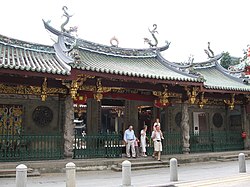Telok Ayer Street
This article needs additional citations for verification. (March 2022) |
Telok Ayer | |
|---|---|
| Name transcription(s) | |
| • Chinese | 直落亚逸 |
| • Pinyin | Zhíluòyǎyì |
| • Malay | Telok Ayer تلوق اءير |
| • Tamil | தேலோக் ஆயர் |
 Telok Ayer Street, one of the earliest thoroughfares in downtown Singapore. | |
| Country | Singapore |
| Planning area | Outram |
Telok Ayer Street
(Malay pronunciation:
Etymology
Telok Ayer Street was originally a coastal road along the Telok Ayer Bay and was named after the bay.[1]
On George Drumgoole Coleman's 1836 Map of Singapore, it was known as Teluk Ayer Street.[1]
The Chinese name for the street is da bo gong miao jie which refers to the
History


In 1822, Telok Ayer Street was the primary area set aside by
Until the late nineteenth century, Telok Ayer Street was the main commercial and residential thoroughfare in Singapore. As immigration from China increased, so did the adverse qualities usually associated with a highly concentrated population. The high trade traffic along the road leads to the road being the center of the early Chinese slave trade in Singapore.[1]
Before land reclamation was done in the area, boats used to moor in Telok Ayer Bay waiting to get fresh water, carried by bullock carts, from a well at Ann Siang Hill.[1]
In 1863, a group of local businessmen including
The street also was the founding site of one of Singapore's oldest schools, Gan Eng Seng School, which was started in 1885 at 106 Telok Ayer Street as the Anglo-Chinese Free School. The historical site marker of the school is nearby at the junction of Telok Ayer and Cecil Streets.

- Matsu, Goddess of the Sea, Queen of Heaven and Patron Deity of Sailors,
- Fuk Tak Chi Temple (1824), former temple first built by the Cantonese and joined by the Hakkas, colloquially known as the mah cau toh peh kong, converted into a museum.
- Ying Fo Fui Kun Hakka Association Hall (1882),
- Ying Fo Fui Kun Temple (1823), the earliest building on the street built by the Hakkas,
- Nagore Durgha Shrine (1828–1830),
- Al-Abrar Mosque(c. 1828), and
- Telok Ayer Chinese Methodist Church (1924).
Conservation and architecture
Telok Ayer Street has been
References

